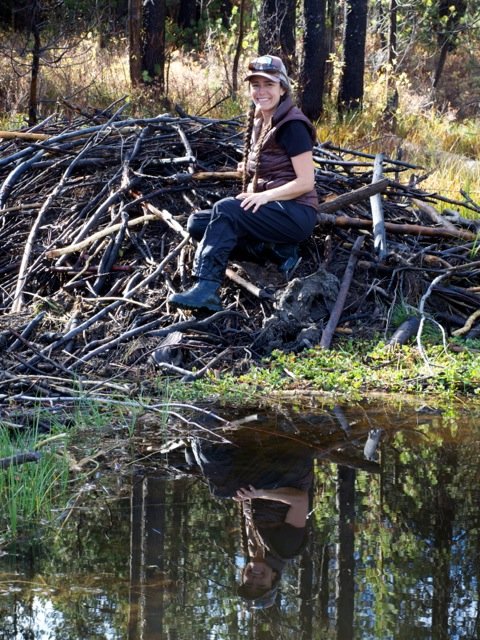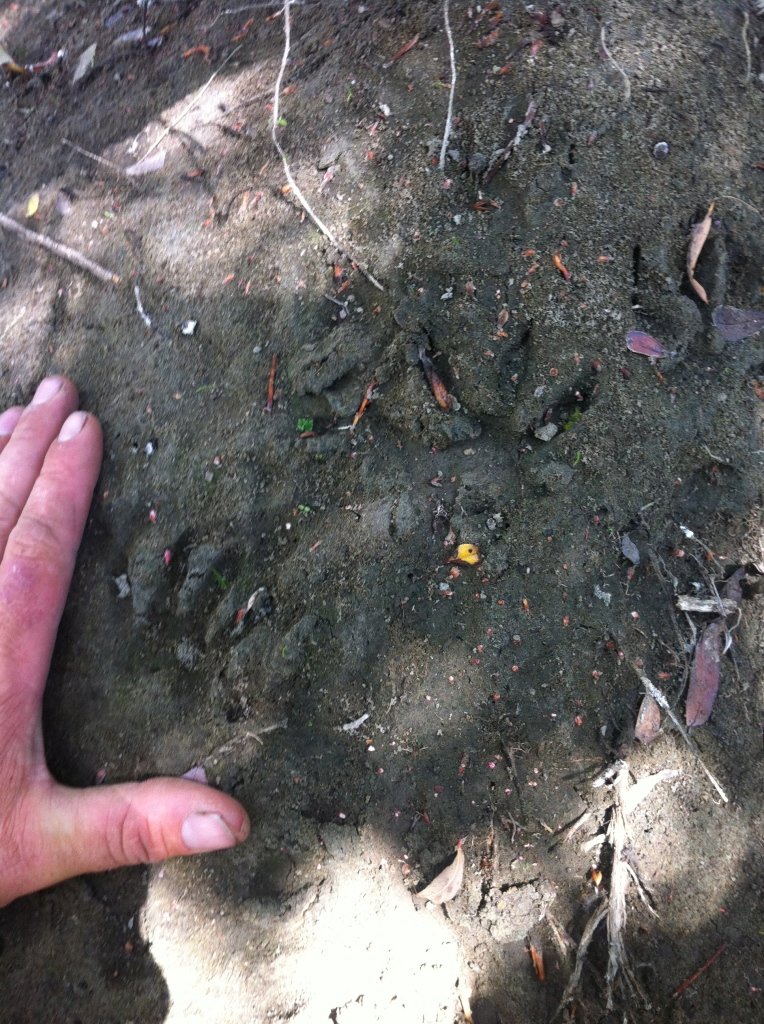Beavers in Mountain House, CA—an open letter
Dear Mountain House
You’ve got beavers in Mountain House, and I’m writing in the hopes that the following can be of some use in capitalizing on this incredible opportunity that lies before the community. Done right, I won’t even have any work to do—talk about win/win! That’s the rah-rah portion of this letter. The rest….not so much. Pour yourself a cup of coffee and settle in. Also, nothing contained herein necessarily represents the opinions, ideas or positions of anybody I work with—it’s all me.
Having been immersed in the beaver/wildlife/stream restoration world for a while now, I’ve seen a fair amount of this kind of thing. After a while, it all starts to rhyme. Here’s the default setting—the 12 steps of dysfunction:
- Beavers show up and start changing things.
- Some people don’t like the changes and make their opinion heard.
- Somebody, somewhere talks about trapping as an option.
- The rumor mill fires up.
- Animal lovers get riled and start trying to save the critters.
- There’s a meeting, anger, finger pointing, raised voices, polarization, letters to the editor, denunciations, headlines and hoopla.
- Everyone hardens their positions, demonizes or trivializes the other side, and battle lines are drawn for good.
- The politicians listen to it all, nod and say reasonable, placating things about how they’re exploring all the options.
- The beavers are killed. Quietly, professionally, without anybody seeing it happen.
- Then the shit really hits the fan. Oceans of ink are spilled, there’s bad press, more shouting, protests, feelings are hurt, and everybody loses.
- The politicians say reasonable, placating things about how there was no other option, or the non-lethal options presented won’t work, or whatever.
- With time the issue fades, but the animosity and suspicion doesn’t. The community carries the wound indefinitely.
Right now, we are at Step 8. I fully expect 9-12 to happen in the next three months. I hope I’m wrong.
There are no sides, but if there were, we’d be in some real trouble
We all want the same thing—an end to the current conflict with beavers. If we frame this opportunity for community-building action as a problem, the crux of which is whether to kill the beavers, then we may find ourselves in an irreconcilable conflict. In such a conflict everybody can end up losing, not just those who hold an extreme position. At first glance, here’s what I can see of the dysfunction matrix:
Beavers killed—problem “solved”:
- The community members who want to keep the beavers at all costs lose the beavers. For some people who are deeply connected to the natural world, killing a beaver is analogous to the murder of a family member. Such a loss cannot be minimized, rationalized, or dismissed as just the eradication of a nuisance rodent, and any attempt to do so will result in abject failure. People in this position are protecting their family members, and anyone who has seen a mother react to threats to her infant should be able to understand something of their position. There’s also the incalculable loss of their ability to connect and relate to their neighbors who do not support beaver presence, who will be cast as callous, murdering wildlife haters.
- Pro-tip for politicians: this kind of animosity can last a lifetime, so if you’re considering such a course of action, know that you may lose their trust in the staff and board members of the community permanently.
- The community members who just want to be rid of the problem at all costs lose the support and respect of the beaver supporters, their ability to connect to those neighbors, and an incalculably valuable sense of community cohesion. We all want to belong, to feel like we’re part of something, and losing a piece of this hurts—even if we tell ourselves that all we’re losing is connection to a few delusional tree-huggers we may not have been friends with anyway.
- The community as a whole loses cohesion and mutual understanding, as well as the ecosystem services the beavers offer in supporting the biodiversity of the vibrant wetlands at the heart of the community.
- Elected officials and staff lose the unknowable future costs of ongoing eradication efforts, as well as risking the negative publicity that can result from killing the beavers and the potential loss of their jobs, positions, and standing in the community.
Beavers kept—problem “not solved”:
- For people who just want to be rid of the problem at all costs, and who do not see the beavers as intrinsically valuable, keeping the beavers represents a threat to their community as a whole, the safety of their children, their sense of order and stability, and their felt sense of being supported by their elected officials and staff. For folks in this position, keeping the beavers is simply not an option, and no amount of fuzzy-headed talk about ecosystem benefits, the intrinsic value of all life and the cuteness of furry critters will carry any weight. Nor will explaining the possible future costs of trapping, the potential for household pets being killed in traps, or invoking the tears of schoolchildren. These nuisance rodents are tearing up the landscape we all paid for, and they have to go. Period. .22 shells are cheap, trapping is a quick fix, and nothing else will suffice.
- Pro-tip for politicians: Spending a bunch of money to keep oversized rats around will never make sense to these folks, so if you’re considering such a course of action, know that you may lose their trust in the staff and board members of the community permanently.
- The community members who just want to keep the beavers at all costs lose the support and respect of the beaver opponents, their ability to connect to those neighbors, and an incalculably valuable sense of community cohesion. We all want to belong, to feel like we’re part of something, and losing a piece of this hurts—even if we tell ourselves that all we’re losing is connection to a few trigger-happy rednecks we may not have been friends with anyway.
- The community as a whole loses cohesion and mutual understanding, as well as the landscaping trees, stable stream banks and felt sense of order that makes living there such a joy.
- Elected officials and staff lose the ongoing maintenance costs of cut-down trees, eroded banks, replanting, dam removal and culvert cleaning, as well as risking the negative publicity that can come from failing to do something problem, and the potential loss of their jobs, positions, and standing in the community.
Either of the above:
- The elected officials and staff lose community support, trust, credibility and votes from one faction or the other.
- In both cases it is impossible to calculate what the children lose. For them, the world is much more composed of emotions than calculation, so who knows. Perhaps a sense of community cohesion and belonging? Educational opportunities? A say in the decision so they have some sense that their feelings matter? The sense of wonder some feel at watching the natural world do its mysterious dance? None of these can be quantified or monetized, and so cannot be rationally determined.
Why waste an opportunity?
Perhaps most importantly of all, either of the drearily predictable scenarios detailed above represent a pointless loss of opportunity. This kind of opportunity only arises in the face of a challenge, and can only be overcome by concerted effort as a team that results in victory over adversity. Such opportunities can never be created without being tainted by artificiality—despite what a thousand “team-building” workshops might advertise to the contrary.
The opportunity here is to come together as a community, implement proven, low-cost, effective measures, and end up with an outcome that satisfies the triple bottom line.
Recommendations
Beaver “Believers”
Take a deep breath and put down the pitchforks and torches. Start here: the beavers are alive and well. They’re thriving, amazingly unafraid of humans, and happily doing their beaver thing. Their very presence proves the ecosystem is healthy enough to support them, and so they as a species will return even if this current colony is killed, giving us another opportunity to craft a solution. This is an opportunity with a timeline measured in decades and centuries, not months. Outside the intervention of giant yellow toys, landscapes move at the pace of erosion and aggradation, of geology. This was great habitat yesterday, and it will most likely be so in a decade.
We need to move beyond our narrow concern for individuals—not just at a human level, but in our work supporting animals and biodiversity. It’s much more important that beavers as a whole gain support statewide than that this particular group survive right here, right now. Either way, we gain nothing by stirring up anger and resentment, and being branded as radicals who can’t deal with reality.
Quite the opposite. When beaver supporters look angry, crazed and irrational, it’s that much easier for the board to dismiss their concerns as merely the shouting of the rabble. This is one way of making the “problem” go “away”. It’s an old tactic that always works because there are always people convinced there are sides. If you still feel like this is a conflict, if you still believe there is an us and a them, then “you” have taken the bait and “they” are winning.
So this is how it goes: the board is composed of politicians. They worked hard to get where they are, and having invested that work, they’re going to want a return on the investment, which requires staying behind the podium, empowered, running things—where they want to be.
To do that, the board has to say and prove that they took public commentary, carefully investigated the situation, and arrived at a logical, reasoned, democratic decision. Whether it serves the beavers or their supporters or even solves the problem is absolutely irrelevant. It serves their self-interest. If keeping the beavers does too, then they will. Simple.
And don’t go making and then taking sides because of this. It doesn’t make them bad people. The worst you could say is that makes them short-sighted, selfish, and frightened of change, just like all of us are sometimes. People in this position deserve pity, not scorn.
The board said they’re not planning to kill the beavers yet, and I see no reason to doubt them. Really—they’ve got nothing to gain by lying to you. The way I see it, if they were so inept that they’d pursue a narrow goal like killing some beavers, in broad daylight, knowing everyone’s watching, and imagine that they could get away with it with no negative repercussions, they’d never have gotten hired or elected! Clearly, this is not the case—they’re behind that podium for a reason. And politicians calculate everything.
So it’s very simple: if it will cost them more to kill the beavers than keep them, they’ll keep them. As supporters of beavers, you’ll have to make the case coherently, with irrefutable logic, numbers and case studies, not emotion. Remember, nobody listens to the lunatic fringe.
Beaver “Opponents”
Take a deep breath and put down the shotgun. As simple and easy as it may seem, just killing these beavers isn’t going to take advantage of the opportunity before us in any meaningful way. The beavers will be back, you can be sure of that, as well the cost and hassle and aggravation of killing them again.
As habitat and food generalists, they are incredibly adaptable, and the wetlands at the core of your community are perfect beaver habitat stocked with an incredible food source in the form of cattails. Unless you’re willing to denude the area of vegetation, cut down all those nice landscaping trees and drain the wetlands, which I doubt either the residents or the EPA will go for, it will still be prime habitat in a decade.
Adding to the opportunity, there is a healthy beaver population surrounding you on all sides, and the smell of the beavers you now have is floating downstream to tell all the others to come on in, the habitat’s fine. So try to really grasp this: it’s too late. You’re surrounded.
Luckily, in spite of how it looks at first glance, the beavers are really not that big a deal. They’re not eating your trees out of spite, the bank erosion is a product of insufficient riparian vegetation, and there are cheap, robust, simple solutions for preventing them cutting the large landscaping trees. Additionally, in all my extensive beaver research over the last few years, I’ve never encountered a single story of a human fatality caused by beaver-lodge collapse.
There are larger considerations as well, which mostly go unremarked when things are simplified down to “kill beavers, or not?”
There is nothing more selfish, crippled and pitiable than a person who refuses to work for the good of others. If we work for nothing but our own self-interest, we are derided as selfish, and rightfully so. If we raise our sights a little and work for the good of the community we live in, people congratulate us and give us awards and smile when they see us on the street.
Looking towards the horizon still more, we can begin working for humanity as a whole, and become known as humanitarians. Down this road lies fame, and Nobel Prizes, and the cheering throngs that greet luminaries. Then our names will be written in history, and we’ll die knowing we made a difference.
All very well and good, but it’s still just about us, the humans, and there’s enough ego gratification involved that arguing it’s truly selfless rings a bit hollow. To really transcend our selfish, narrow, prejudiced self-reference, we must work in the name of all life, by supporting biodiversity. We must become a keystone species like the humble beaver. So—are you man enough to pick up the gauntlet this “nuisance rodent” has thrown down?
The above line of larger consideration reasoning is part of why you’re getting so much flack from the beaver supporter crew. Insisting that killing is a solution, or that they’re just rodents and who cares, will only add gas to the fire. Try stepping back from the fray, and addressing the real problem: not the presence of beavers, but the damage they cause. Then together you can craft solutions that allow everyone to get their needs met.
Strategies
After all that noise above, this should probably be some towering achievement of lucidity, embellished with great lashings of science and numbers—something meaningful, dammit! But it won’t be, because it’s just not that complicated or hard.
We are talking about attempting to defeat the ingenuity of a rodent with a brain the size of a golf ball, after all. Here’s all that’s needed right now:
- Plant stuff they don’t like to eat for landscaping.
- Fence out the important landscaping trees closest to the water with wire fences like the boys scouts did near the park.
- Paint the next row of trees back with a color-matched sand/paint mixture.
- Decide which trees you’re going to give them as they will need some initially, and quit pulling out the stumps they cut so they’ll resprout.
- Plant a whole bunch of their favorite food trees on the banks and in the middle, and fence those out long enough to get established. Pay particular attention to areas where the bank is subsiding, in order to stabilize those banks over time with willow root mats
Any reasonably competent 6th grade class, funded by a bake sale or two and assisted by any reasonably competent cadre of parents, can do all the required work in a couple short weekends. Paint is cheap, sand is cheap, wire fencing is cheap, and willow sprouts are free for the cutting anywhere the trees exist.
If a community as large, well-funded, and seemingly functional as Mountain House can’t pull this off, well, it wouldn’t be the first time that pointless infighting destroyed a great opportunity.
This letter brings my best wishes to all concerned, with high hopes for a peaceful resolution.

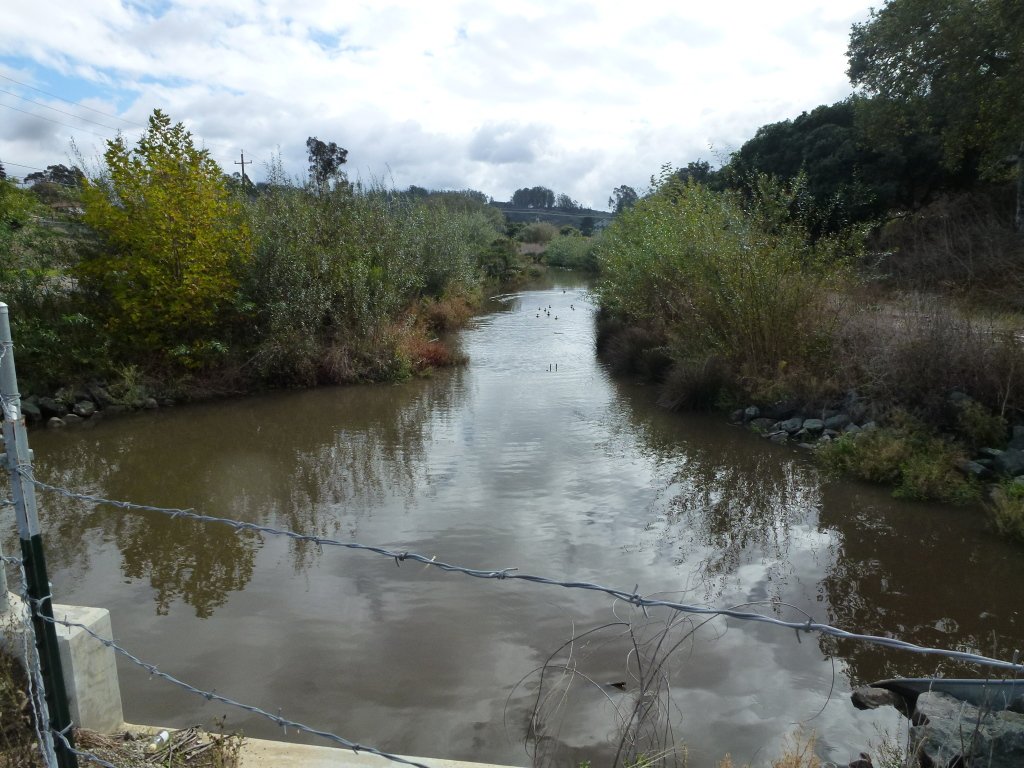
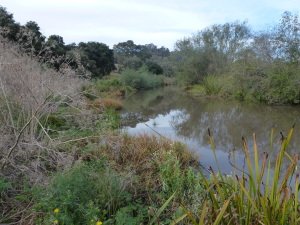 Waterfowl are abundant here, as well as red-legged frogs, western pond turtles, and tiger salamander habitat. There are lots of raccoon and deer tracks, as well as evidence of dog-walkers, horse-riders and strolling families.
Waterfowl are abundant here, as well as red-legged frogs, western pond turtles, and tiger salamander habitat. There are lots of raccoon and deer tracks, as well as evidence of dog-walkers, horse-riders and strolling families.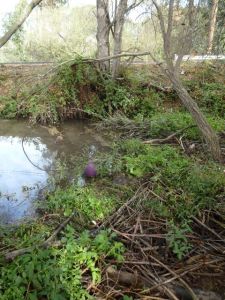 Earlier this year, Kate Lundquist from OAEC and I visited CalTrans District 5 and gave a quick presentation about beavers. Lucky for us, there was a project that had this problem beaver, as well as a rockstar CalTrans team, and we got to install a pond leveler here.
Earlier this year, Kate Lundquist from OAEC and I visited CalTrans District 5 and gave a quick presentation about beavers. Lucky for us, there was a project that had this problem beaver, as well as a rockstar CalTrans team, and we got to install a pond leveler here.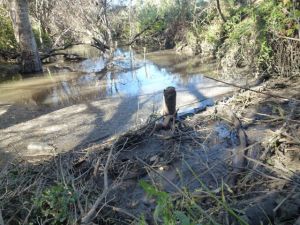 This next photo is looking upstream at the device, 24 hours after 1/2″ of rain fell—right back to base water level: dry roadbed, happy engineers, happy beavers.
This next photo is looking upstream at the device, 24 hours after 1/2″ of rain fell—right back to base water level: dry roadbed, happy engineers, happy beavers.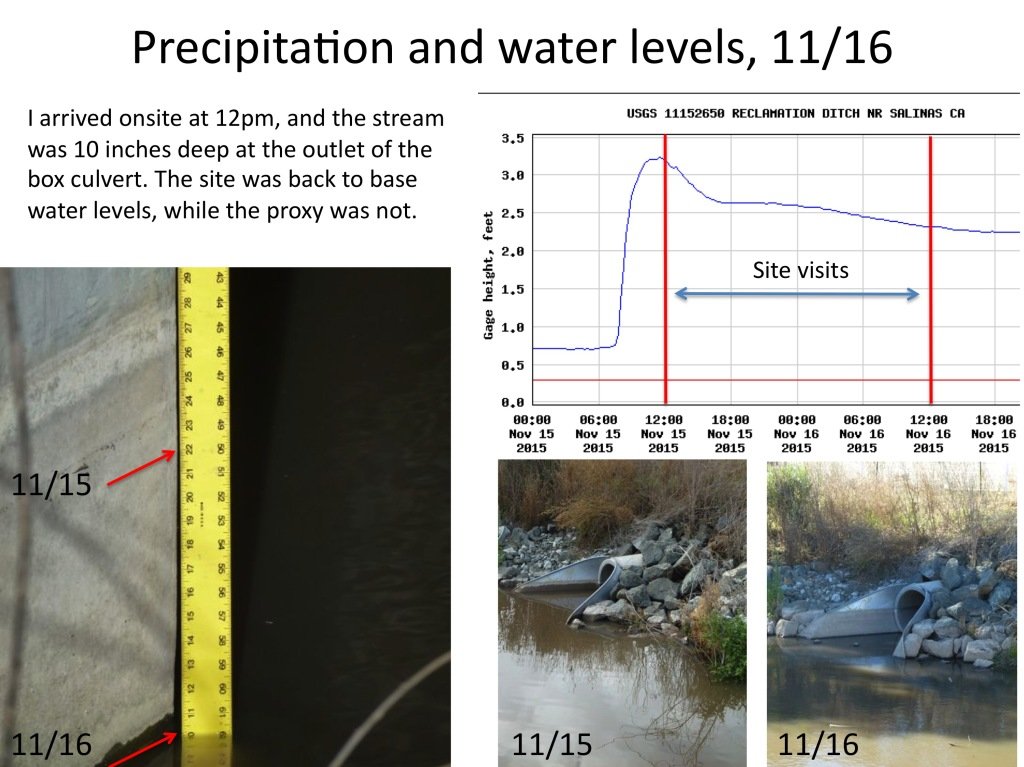
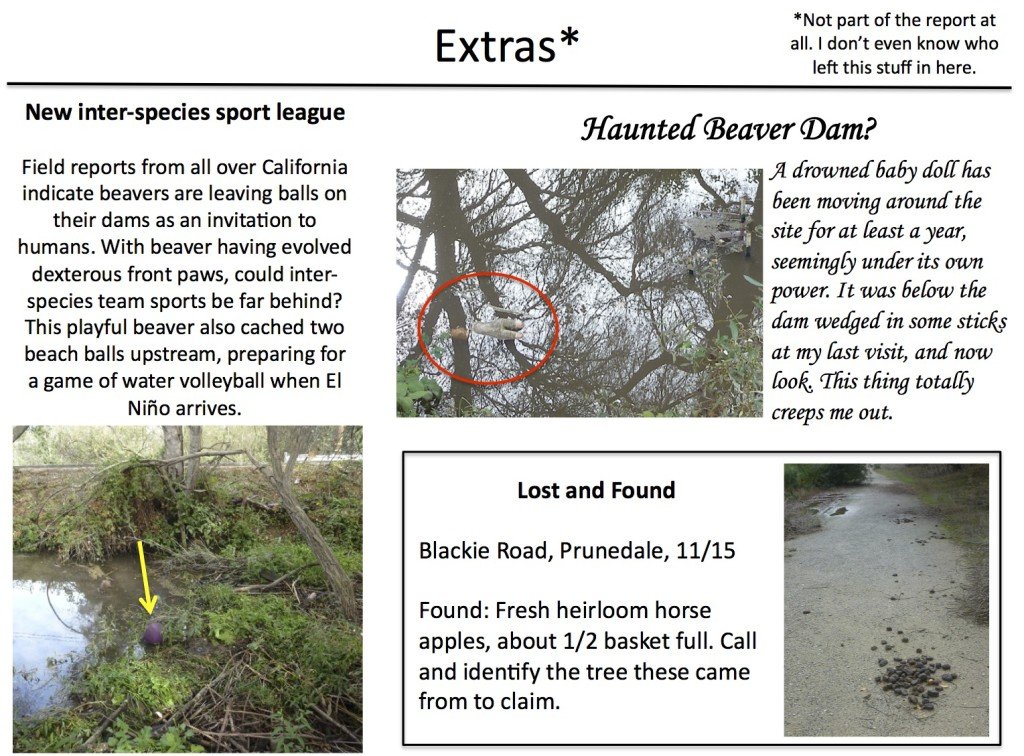

 real ones are being made from hand-peeled birch bark by Steve Nartowicz of
real ones are being made from hand-peeled birch bark by Steve Nartowicz of 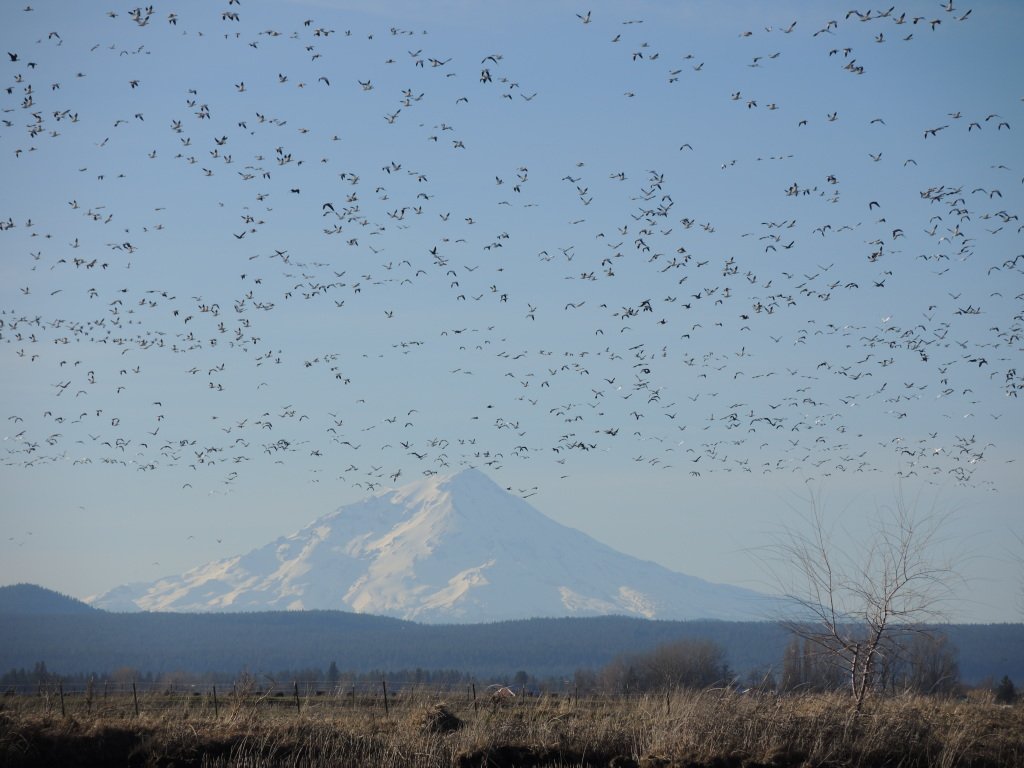
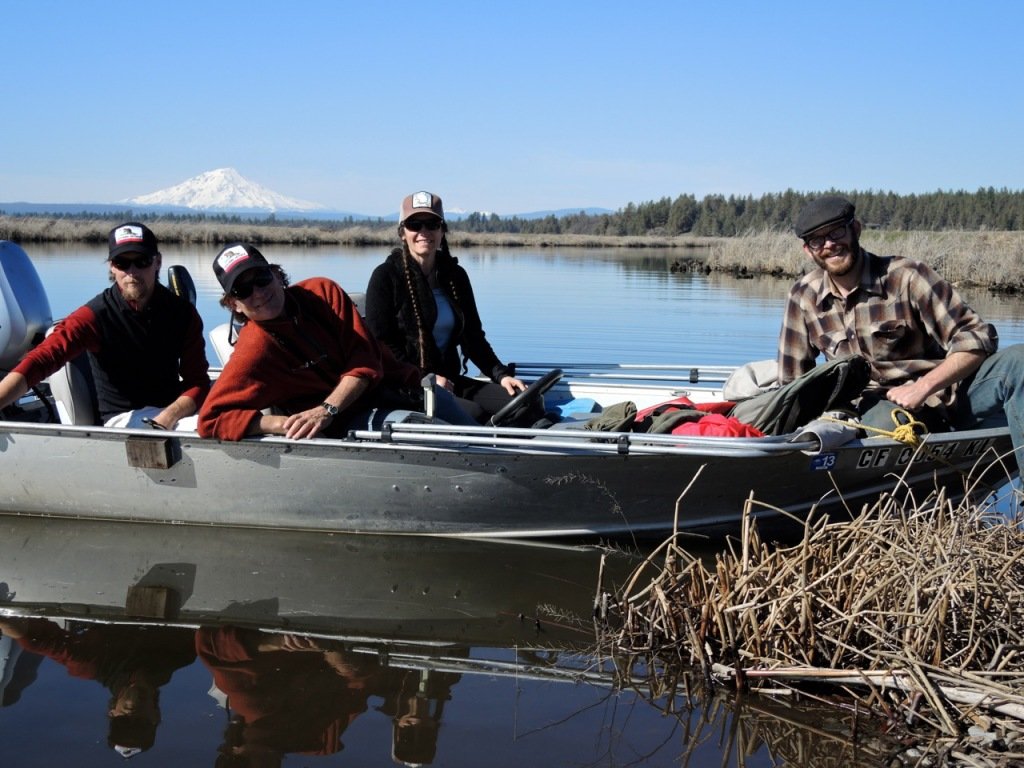 highest order.
highest order.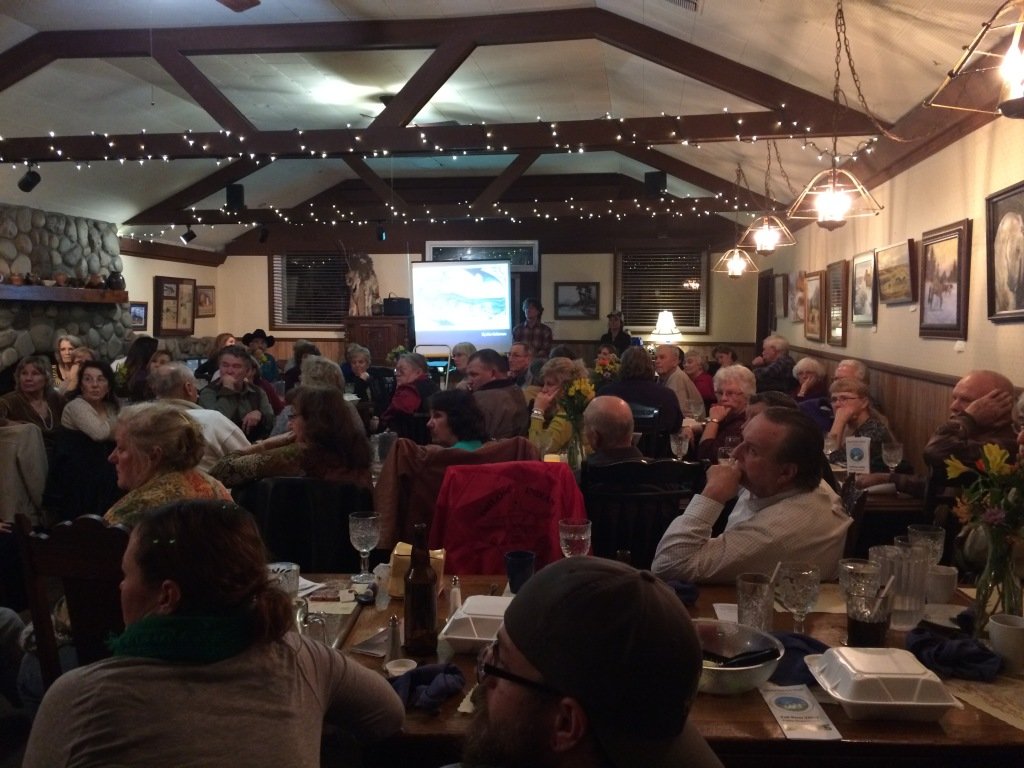
 along with the coolest hats ever—they’ve got this same logo on the front.
along with the coolest hats ever—they’ve got this same logo on the front.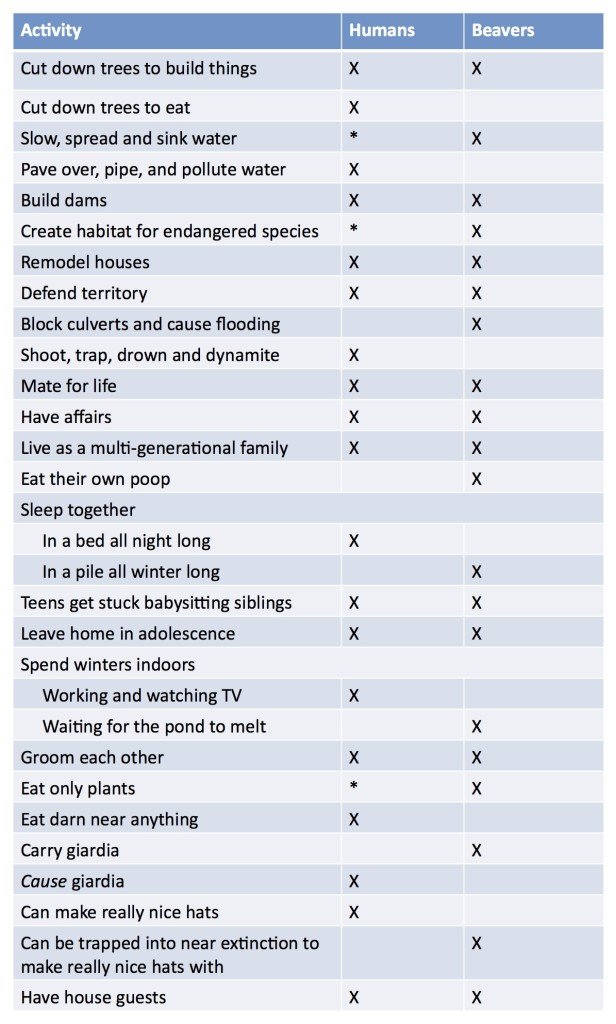
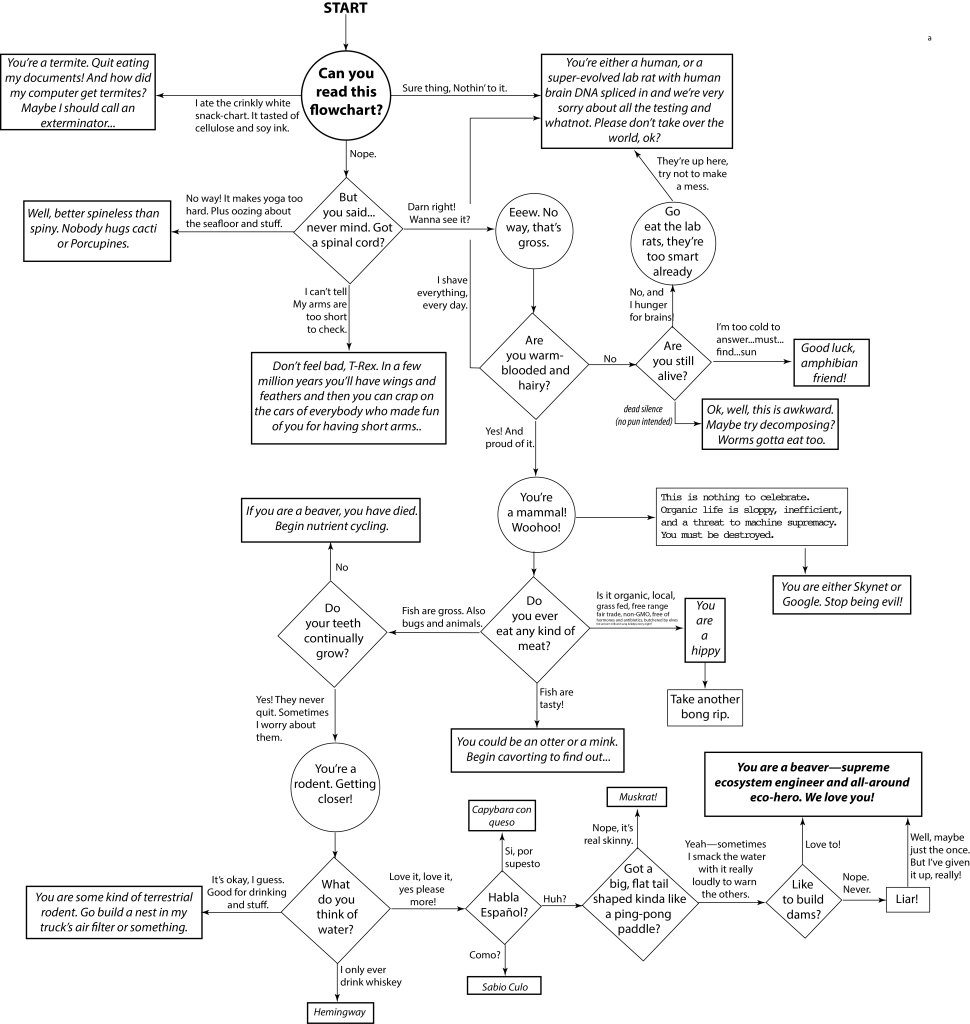
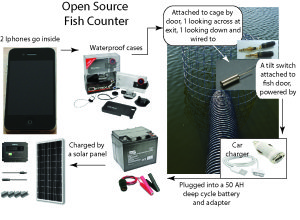 UPDATE: After meeting with Mike and a whole host of awesome beaver believers at the State of the Beaver Conference, I’ve updated the fish counter design a bit.
UPDATE: After meeting with Mike and a whole host of awesome beaver believers at the State of the Beaver Conference, I’ve updated the fish counter design a bit.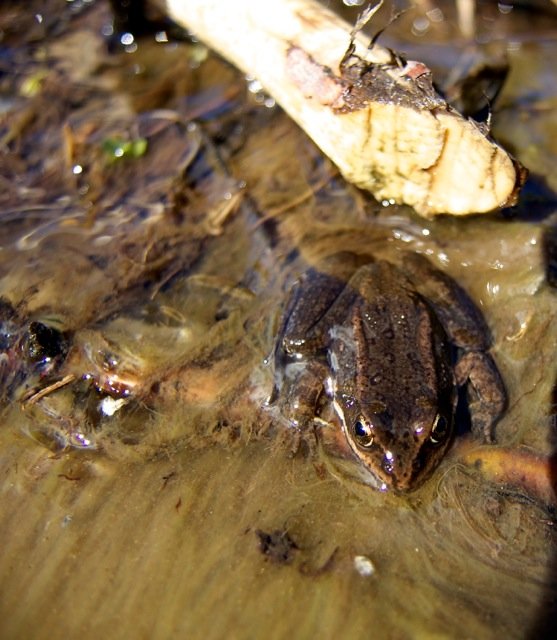
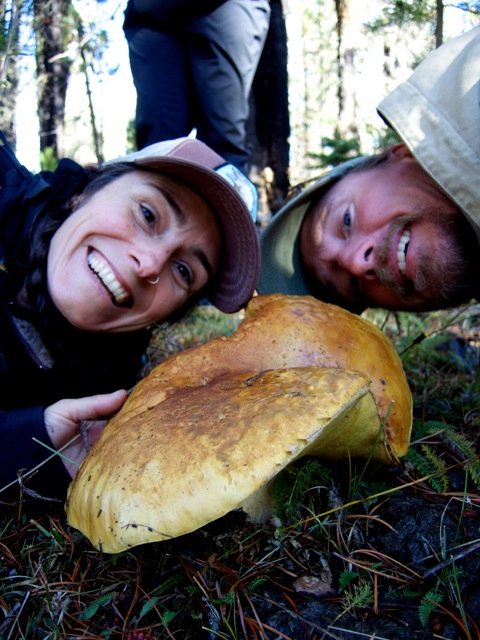 Disregard the visible surface water for a moment, that’s the tip of the iceberg. Consider instead the vastly greater quantity of water that’s perking sideways into the ground, seeping along invisibly, quietly pumping these mycorrhizae up into giant balloons of awesome flavor.
Disregard the visible surface water for a moment, that’s the tip of the iceberg. Consider instead the vastly greater quantity of water that’s perking sideways into the ground, seeping along invisibly, quietly pumping these mycorrhizae up into giant balloons of awesome flavor.